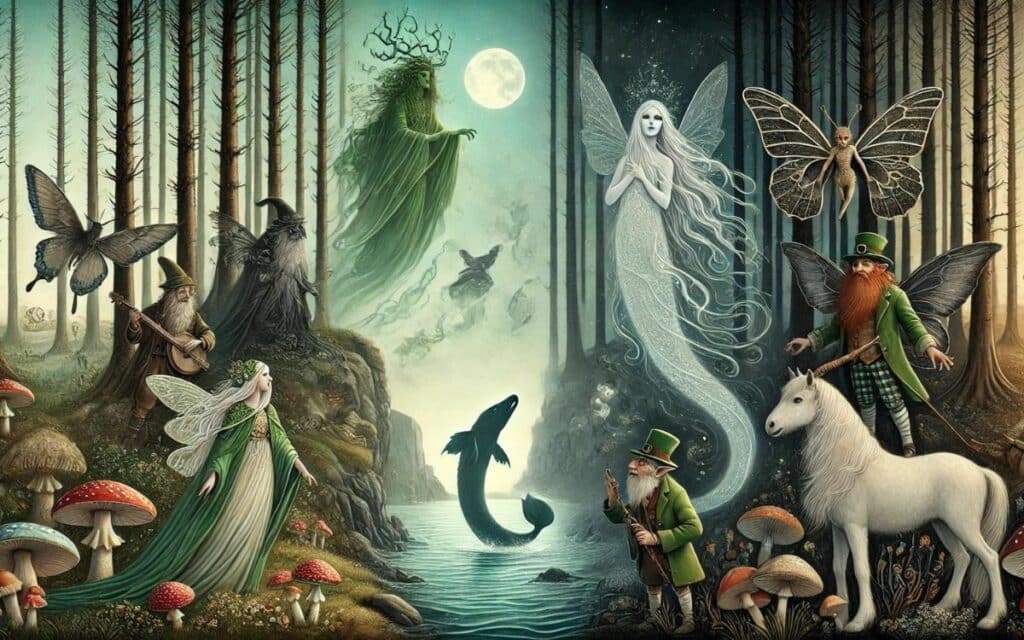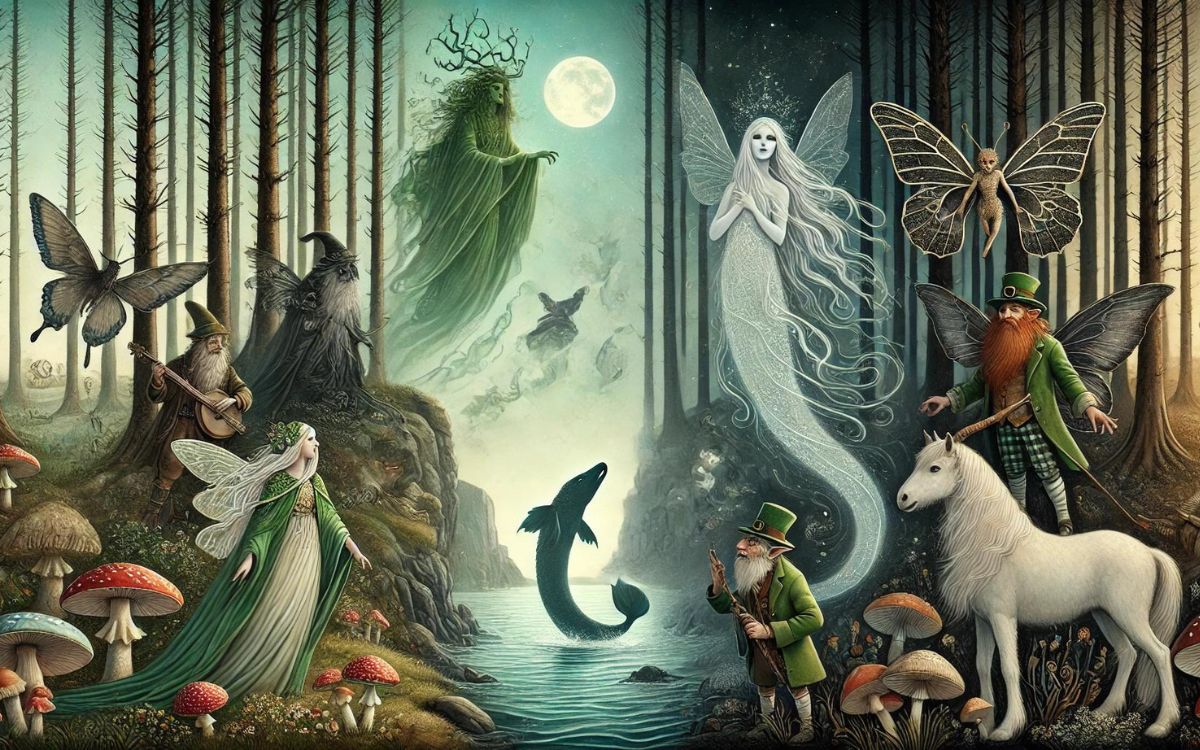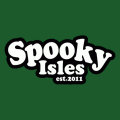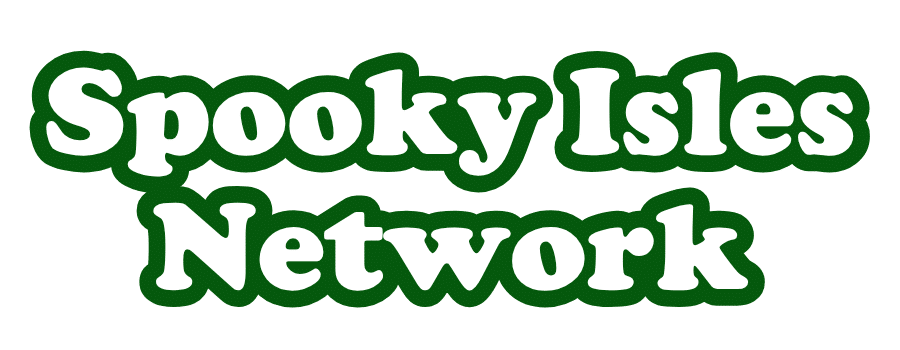Welcome to the glossary of British and Irish folklore creatures! Here, strange and wonderful beings like mischievous fairies, ghostly animals, headless riders, and ancient spirits roam, reflecting the landscapes and beliefs of their storytellers

Abhartach: In Irish folklore, Abhartach is a dwarf known for his malevolent behaviour. He is often described as a creature who brings disease and death to his surroundings.
Afanc: A creature in Welsh folklore, the Afanc is a malevolent water monster associated with lakes and rivers. It is believed to bring destruction and chaos.
Aos Sí: A supernatural race in Irish folklore, the Aos Sí are powerful beings connected to nature and the other world.
Asrai: A water spirit from English folklore, the Asrai is often linked with good fortune. Described as a beautiful female spirit, she is believed to bring luck to those who see her.
Banshee: A female spirit in Irish folklore known for foretelling death. The Banshee’s wail is said to announce the imminent death of a family member. Read about Banshees.
Baobhan Sith: In Scottish folklore, the Baobhan Sith is a vampire that appears as a beautiful woman. She lures men by dancing with them until they are exhausted, then feeds on their blood.
Barghest: A ghostly black dog from Northern English folklore, associated with death and misfortune. The Barghest is often depicted as a large spectral dog haunting the moors and countryside.
Bean Nighe: A spirit in Scottish folklore portrayed as a washerwoman washing the clothes of those about to die. She is considered a harbinger of death. Read about Bean Nighe.
Black Annis: A spirit from English folklore, Black Annis is said to haunt the countryside and cause trouble for its inhabitants.
Black Shuck: A ghostly black dog in East Anglian folklore, often seen as a harbinger of death. This large, spectral creature is said to roam the countryside. Read about Black Shuck.
Bluecap: Spirits in English and Scottish folklore associated with mines and caves. Bluecaps are known for their mischievous behaviour, often causing trouble for miners.
Boggart: A spirit in English folklore that haunts houses and causes trouble for their inhabitants. Read about Boggarts.
Brownie: A helpful household spirit from Scottish and English folklore, often depicted as a small, bearded creature who performs household chores in exchange for small gifts. Read about Brownies.
Buggane: A giant from Manx folklore known for his destructive behaviour. Bugganes are malevolent creatures that cause chaos and destruction.
Bwbachod: Fairies in Welsh folklore known for their helpful nature. They are believed to protect homes and bring good fortune to the residents. Read about Bwbachod.
Cat Síth: A large black cat from Scottish and Irish folklore, thought to be a witch in cat form. The Cat Síth is considered a malevolent creature that brings bad luck.
Ceffyl Dŵr: A water horse in Welsh folklore, said to inhabit rivers and lakes.
Changeling: In British and Irish folklore, a Changeling is a fairy that takes the place of a human child, often causing trouble for the family. Read about Changelings.
Clurichaun: A fairy from Irish folklore, known for its love of alcohol. Often depicted as a small, drunken creature that guards wine cellars.
Corpse Candle: A ghostly light in British and Irish folklore associated with death. It appears before a death or disaster occurs. Read about Corpse Candles.
Cù Sìth: A spectral dog in Scottish folklore, seen as an omen of death. The howling of the Cù Sìth is believed to foretell someone’s death.
Cŵn Annwn: Ghostly hounds in Welsh folklore, thought to hunt the countryside and bring fear to those who see them.
Cyhyraeth: A Welsh spirit associated with death and mourning. Often portrayed as a female spirit who wails at night, foretelling death.
Dando: A malevolent spirit from West Country folklore, known for its destructive behaviour.
Dandy Dogs: A pack of ghostly dogs in English folklore, believed to be a harbinger of death.
Deryn Corff: A bird in Welsh folklore associated with death. It is said to feed on human flesh.
Dip: A water spirit in Scottish folklore believed to live in water and cause chaos.
Dragon: A large, fire-breathing reptile from Welsh mythology, known for its destructive power. Read about Welsh dragons.
Dullahan: The headless horseman in Irish folklore, a harbinger of death who rides a black horse and carries his head under his arm. Read about Dullahan.
Elf: Supernatural beings in Germanic and British folklore, often depicted as beautiful creatures with a connection to nature.
Fachen: A giant in Irish and Scottish folklore, associated with death and seen as a malevolent omen. Read about Fachen.
Fae/Fairy: Mischievous creatures from British and Irish folklore, known for their supernatural abilities.
Faoladh: A werewolf in Irish folklore, believed to protect the countryside and bring good fortune.
Fir Darrig: A fairy in Irish folklore known for its mischievous behaviour, often depicted as a small red creature.
Firbolg: A supernatural race in Irish mythology with magical powers.
Fomorian: Giants in Irish mythology known for their destructive nature.
Fuath: A water spirit in Scottish folklore, often associated with death.
Gancanagh: A seductive fairy in Irish folklore.
Ghillie Dhu: A protective fairy from Scottish folklore, known to guard forests.
Giant: Large humanoid beings known for their size and strength.
Glaistig: A spirit in Scottish folklore that lures travellers.
Goblin: Mischievous fairies from British folklore. Read about Goblins.
Grindylow: A water spirit in English folklore known for dragging people into water.
Gwyllgi: A black dog in Welsh folklore associated with death.
Hag: A supernatural being in British folklore, often portrayed as an old woman with magical abilities.
Hellhound: A ghostly black dog in British folklore, considered an omen of death.
Hobgoblin: Mischievous fairies from British folklore.
Imp: Small, mischievous fairies from British folklore.
Kelpie: A shape-shifting water spirit from Scottish folklore.
Korrigan: Mischievous fairies from Breton and Cornish folklore.
Leanan Sidhe: A fairy from Irish folklore associated with love and death.
Leprechaun: A fairy from Irish folklore, said to guard a pot of gold. Read about Leprechauns.
Ly Erg: A giant in Manx folklore known for haunting the hills.
Melusine: A spirit in French and English folklore, often depicted as a beautiful female with a serpent’s tail.
Mermaid: Female water spirits associated with the sea. Read about Mermaids.
Morgen: Seductive water spirits in Cornish and Breton folklore.
Nanny of the Meadow: A protective fairy in English folklore.
Old Stinker: A werewolf-like creature in British folklore.
Pixy-Led: Ghostly lights in English folklore that lure travellers off the path.
Pooka/Puca: A shape-shifting creature from Irish folklore.
Rawhead and Bloody Bones: A malevolent spirit in English folklore, often used to frighten children.
Red Man: A malevolent spirit in English folklore.
Selkie: Water spirits in Scottish and Irish folklore that take the form of seals. Read about Selkies.
Shee: A fairy race in Irish folklore.
Spriggan: Treasure-guarding fairies in Cornish folklore. Read about Spriggan.
Tylwyth Teg: A race of fairies in Welsh folklore. Read about Tylwyth Teg.
Unicorn: A mythical creature associated with purity and grace.
Vampire: Malevolent spirits that feed on blood, common in British and Eastern European folklore. Read about Vampires.
Werewolf: Humans that transform into wolves, common in British and European folklore. Read about Werewolves.
Will-o’-the-wisp: Ghostly lights that lure travellers off the path. Read about Will-o’-the-wisp.
Wyvern: Creatures with the body of a dragon and the wings of a bat.
Ysgithyrwyn: A supernatural boar in Welsh folklore associated with good fortune.
What’s your favourite creature from British and Irish folklore? Tell us in the comments section below!



